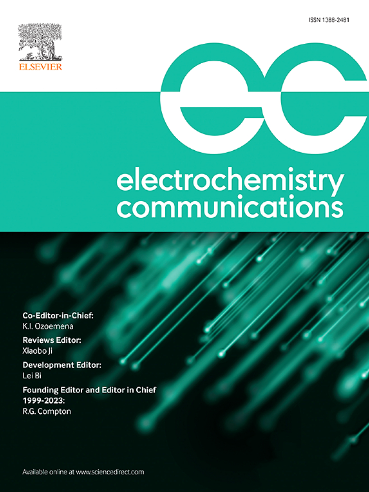Enhancing the performance of supercapacitor electrodes from corncob-derived 3D hierarchical porous carbon: Effects of N concentration
IF 4.2
3区 工程技术
Q2 ELECTROCHEMISTRY
引用次数: 0
Abstract
We report supercapacitors from hierarchical porous carbon nanostructures (HPCNs) by simple pyrolysis of corncob (CC), with urea doping providing performance comparable to the more common metal-doped electrodes. Via a systematic study of N doping, we establish for the first time that the types of nitrogen‑carbon species, which vary with the urea‑carbon ratio, affect electrode performance. The 1:3 ratio (CC3) gave a higher specific capacitance of 335 F g−1 at 1 mV s−1 in a three-electrode system, and 287 F g−1 at 0.2 A g−1 in a symmetric device. We achieved solution and transfer resistances lower than reported for other materials: Rs = 0.20 Ω and Rct = 0.78 Ω respectively. We attribute the better performance of CC3 to its specific N-doping, dominated by graphitic-N plus oxidized nitrogen and C–OH groups; showing also a larger carbon (002) interplanar distance (d(002) = 0.392) and high specific surface area (1149 m2 g−1). The assembled prototype delivers a good energy density of 9.96 Wh kg−1 at 403.22 W kg−1 and retains ca. 76 % capacity after 10,000 cycles. This work shows that studying doping concentrations is essential to design and produce highly efficient biomass-based electrodes for energy storage applications, using simple synthesis methods and readily available reagents.

玉米棒子衍生的三维分层多孔碳增强超级电容器电极性能:N浓度的影响
我们报道了通过玉米芯(CC)的简单热解从分层多孔碳纳米结构(HPCNs)中获得的超级电容器,其中尿素掺杂提供了与更常见的金属掺杂电极相当的性能。通过对N掺杂的系统研究,我们首次确定了氮碳种类随尿素碳比的变化对电极性能的影响。1:3的比例(CC3)在三电极系统中具有更高的比电容,在1 mV s−1时为335 F g−1,在对称器件中为0.2 a g−1时为287 F g−1。我们获得了比其他材料更低的溶液和转移阻力:Rs = 0.20 Ω和Rct = 0.78 Ω。我们将CC3更好的性能归因于其特定的n掺杂,主要是石墨- n +氧化氮和C-OH基团;同时显示出较大的碳(002)面间距(d(002) = 0.392)和较高的比表面积(1149 m2 g−1)。组装的原型在403.22 W kg - 1时提供了9.96 Wh kg - 1的良好能量密度,并在10,000次循环后保持约76%的容量。这项工作表明,使用简单的合成方法和现成的试剂,研究掺杂浓度对于设计和生产用于储能应用的高效生物质电极至关重要。
本文章由计算机程序翻译,如有差异,请以英文原文为准。
求助全文
约1分钟内获得全文
求助全文
来源期刊

Electrochemistry Communications
工程技术-电化学
CiteScore
8.50
自引率
3.70%
发文量
160
审稿时长
1.2 months
期刊介绍:
Electrochemistry Communications is an open access journal providing fast dissemination of short communications, full communications and mini reviews covering the whole field of electrochemistry which merit urgent publication. Short communications are limited to a maximum of 20,000 characters (including spaces) while full communications and mini reviews are limited to 25,000 characters (including spaces). Supplementary information is permitted for full communications and mini reviews but not for short communications. We aim to be the fastest journal in electrochemistry for these types of papers.
 求助内容:
求助内容: 应助结果提醒方式:
应助结果提醒方式:


